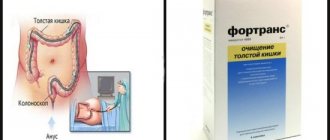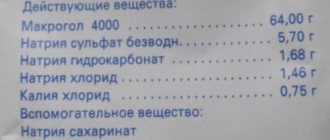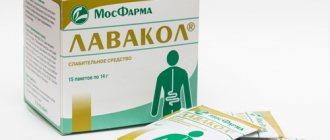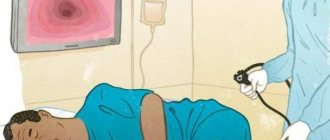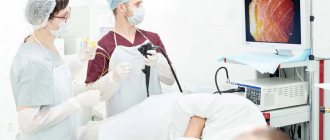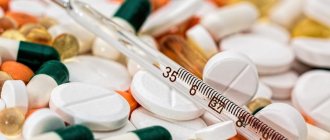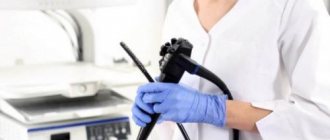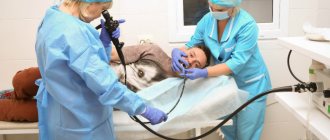Colonoscopy is a diagnostic procedure of the colon performed using a colonoscope. This type of study helps to examine the entire colon for tumors and fistulas. Colonoscopy is prescribed for patients with chronic abdominal pain, blood in the stool, ulcerative colitis, diarrhea, and those suffering from unexplained weight loss. What should be the preparation for a colonoscopy with the drug Fortrans?
How is a colonoscopy performed, and why should you prepare for it?
Fortrans for colon cleansing
Preparation for colonoscopy plays an important role; Fortrans and other drugs will help cleanse the intestines completely. The better the preparation, the more accurate the research results will be. This procedure is usually performed by an endoscopist, without anesthesia. If the patient is admitted with pain in the anus or abdomen, local anesthesia is possible. General anesthesia is used only in the most extreme cases.
To minimize discomfort during the procedure, you must listen carefully to the doctor and follow all his instructions. You need to lie on your side, pulling your knees to your chest. The doctor may ask you to turn on your back or stomach. The sensations during colonoscopy are quite unpleasant, reminiscent of an intestine full of gases, and the urge to defecate is possible. Therefore, it is extremely important to cleanse the intestines before the procedure.
Pain may intensify when the device overcomes the bends of the intestine. If necessary, the doctor can do a biopsy - take tissue for testing using special forceps. This will prolong the procedure by a couple of minutes. The likelihood of complications is low. The most dangerous of them is intestinal perforation. After the colonoscopy is completed, it is advisable to remain lying on your stomach for a while.
There is no rule that you cannot eat for a while after the procedure. However, it is not advisable to eat too much right away. Food should be light.
During colonoscopy under sedation (intravenous anesthesia)
It is necessary to maintain a fasting period of at least 8 hours and at least 4 hours without water. On this day it is not recommended to drive a car, operate any machinery, or make important decisions. It is advisable to be met and escorted home.
When making an appointment for gastro + colonoscopy, two-stage preparation is not suitable, since the patient must come to gastroscopy on an empty stomach, not eat or DRINK!
IMPORTANT: In case of concomitant pathology of the cardiovascular system, diabetes mellitus, renal failure, preparation with MOVIPREP is more justified.
After completing the examination and receiving the results of a colonoscopy, it is recommended to consult a gastroenterologist.
Author of the material: doctor Endoscopist of the clinic on Nikulinskaya Parshin E. E.
Preparing for colonoscopy using Fortrans
It is extremely important that during the procedure the intestines are cleared of feces that make examination difficult. The most common and reliable method is to cleanse the intestines using Fortrans. This drug is intended specifically to prepare the body for such procedures, for intestinal examination or surgery. The solution has a pleasant fruity taste. If the taste does not seem very pleasant, you can drink the drug with water. This effective medicine ensures complete bowel movement without resorting to enemas and without abdominal pain. One-stage preparation is carried out as follows:
- The day before going to the endoscopist, you should not eat foods such as vegetables and fruits, as well as anything that causes fermentation processes in the stomach, such as black bread.
- On the day of the study, it is advisable to switch to drinking (only tea and water, it is advisable to exclude even juices)
- On the same day, you need to dilute Fortrax in boiled water: 1 sachet per 1 liter of water. The instructions will help you correctly calculate the dose based on your weight.
- Drink the solution in fractional portions. Take no earlier than 2 hours after meals, drink slowly.
- The intestines begin to empty 1-1.5 hours after taking Fortrans, stool stops after 2-3 hours.
- It is necessary to calculate the time of taking the drug so that the colonoscopy is performed no earlier than 4 hours after the last dose of Fortrans.
Another preparation option is called two-stage:
- The morning before the procedure, a light breakfast is allowed: porridge or yogurt.
- The rest of the day, take only liquid food: broth, tea, boiled water.
- Fortrans should be taken in small portions in the afternoon.
- The next morning (on the day of the test), take another 1 liter of solution with 1 sachet of the drug. Compliance with all the rules guarantees excellent preparation of the body for colonoscopy.
One-stage preparation scheme
It is recommended when conducting the study in the morning before 11:00.
- 3 and 2 days before the test, follow a slag-free diet.
- 1 day before the test, before 13:00, take only liquids and do not eat solid food.
From 16:00 to 20:00 - take 1 liter of Fortrans (for 4 hours, 1 glass every 15 minutes).
On the day of the examination, during the procedure without painkillers, you can drink tea with honey or still water. When performing the procedure under sedation (with pain medication), you must avoid eating and be on an empty stomach.
The indicated administration time can be changed, but it is important to remember that it is recommended to finish taking the last dose of Fortrans 3-4 hours before the start of the study.
Other ways to prepare for a colonoscopy
Fortrans must be prepared strictly according to the instructions.
For persistent constipation, if there has been no bowel movement for several days, you can use the following colon cleansing regimen before colonoscopy. A couple of days before the key moment, you need to start following a special diet called a slag-free diet. It allows cereals, eggs, boiled lean meat, broths, and low-fat fermented milk products.
- On the day of going to the hospital, only liquid food is allowed: water, broth (clear) and tea.
- The day before you need to drink 2 tablespoons of castor oil. It's not easy, but this oil will help cleanse the intestines quickly and effectively.
- After you go to the toilet, you need to do an enema, preferably two. You may feel like your bowels have completely emptied, but this is not always the case. The colonoscopy procedure requires complete cleansing. Therefore, use plain water at room temperature for enemas.
- The next morning you need to do 1-2 more of the same enemas. In this case, clear water without feces should flow out. Now you are ready for the procedure.
It is also possible to cleanse the intestines with the laxative Lavacal. It is necessary to dissolve 1 sachet of powder in 200 ml of clean water. Drink this solution on an empty stomach the day before the procedure. In total, you need to drink 3 liters of Lavacal solution, 200 ml every 20 minutes. After this, only liquid food is allowed. In the evening, after 10 o'clock it is not advisable to eat. In rare cases, side effects are possible when taking Lavacal: nausea, vomiting. In this case, the drug must be stopped.
Slag-free diet
YOU CAN take refined foods and easily digestible foods:
- Boiled meat (low-fat varieties), fish, chicken
- Bouillon
- Low-fat fermented milk products without fruit additives
- Boiled eggs
- Omelette
- Honey
- Jelly
- Not strong tea or coffee, clear juices without pulp
- Not sparkling water
DO NOT eat foods rich in fiber and poorly digestible foods:
- Grain products, cereals
- Fruits, vegetables, berries, greens
- Cereals, legumes, nuts
- Fatty meats, fish, poultry, mushrooms
- Cream soups, smoked meats, canned food, sausages
- Full fat dairy products
- Bread, sweets
- Alcohol and carbonated drinks
Analogues of the drug
There are quite a lot of analogues (pharmaceutical equivalents) of Fortrans, but you cannot replace prescribed drugs without consulting your doctor, as they may differ in the list of contraindications and side effects. If for some reason a person cannot undergo cleansing with Fortrans (for example, with a pronounced gag reflex), you can use other medications from the group of laxatives listed in the table below.
Table. Analogues of the drug "Fortrans".
| Name | Mode of application | Contraindications | Price |
| Administer 5 ml of the drug (1 microenema) rectally. If necessary, repeat after 4 hours. | The drug is available in the form of a solution for rectal administration, so the only contraindication for use is hypersensitivity to macrogol. | 325 rubles | |
| Dilute 1-2 packets with boiled water at room temperature and drink in the morning or evening before the procedure. | Inflammatory processes in the large intestine, perforation of an ulcer, gastric or intestinal bleeding, unspecified abdominal pain. | 252 rubles | |
| Dissolve 1-2 packets in water (use 100 ml of liquid per 1 packet) and take at one time. | All contraindications listed in the annotation for Fortrans, as well as phenylketonuria (the product contains aspartame). | 170 rubles |
Choosing a regimen for taking the FORTRANS® drug depending on the time of the examination
SURVEY 08:00–14:00
Two-stage scheme (2 liters of FORTRANS® solution is taken in the evening before the examination day and 2 liters in the morning on the examination day):
- 19:00–21:00 take the first liter of FORTRANS® solution (the start time of administration can be changed to later, taking into account the active effect of the drug for an average of 1.5–2 hours and time for sleep).
- Choose the time for the morning intake of the second liter of FORTRANS® solution so that a minimum of 2 hours and a maximum of 4 hours pass from the end of the drug intake to the examination.
- To the last 500 doses of FORTRANS®, add 30 ml /or 6 capsules/ of ESPUMIZAN.
SURVEY 14:00–19:00
One-stage morning regimen (4 liters of FORTRANS® solution are taken in the morning on the day of the examination):
- 08:00–10:00 take two liters of FORTRANS® drug solution (the recommended time for examination is indicated at 14:00–14:30; for a later examination time, the start of taking the drug should be shifted accordingly).
- Choose the time for taking the third and fourth liters of FORTRANS® solution so that a minimum of 2 hours and a maximum of 4 hours pass from the end of the drug intake to the study.
- To the last 500 ml of FORTRANS®, add 30 ml /or 6 capsules/ of ESPUMIZAN.
Preparing and performing a colonoscopy
Colonoscopy is the most accurate examination of the inner surface of the colon and rectum using a special flexible endoscope. Using this flexible tube with a light-conducting fiber and a video camera, the doctor examines all parts of the colon and rectum.
Why do a colonoscopy
First of all, colonoscopy allows you to identify intestinal tumors: both malignant (cancer) and benign (polyps). It is possible to detect various variants of inflammatory changes in the mucous membrane - colitis, proctitis, or its ulcerative lesions - solitary ulcers, erosions, fissure ulcers. It is also important to establish the cause of bleeding from the intestines.
Who should have a colonoscopy?
The World Health Organization recommends that everyone over 45 years of age undergo a colonoscopy to prevent colon cancer.
Signs that should alert you and indicate the need to perform the procedure:
- discharge of blood from the anus, especially dark in color and with clots,
- detection of occult blood in the stool,
- mucus discharge from the anus,
- regularly recurring constipation, diarrhea or their alternation,
- decreased hemoglobin levels (anemia),
- increase in specific tumor markers in blood tests,
- colon tumors in close relatives.
It is also regularly necessary to undergo colonoscopy for those who have been operated on for a colon tumor in order to timely detect a recurrence of the disease.
How is a colonoscopy performed?
- You must remove all clothing from the waist down, then put on special underwear for colonoscopy.
- The study is carried out lying down. During the procedure, the doctor may ask you to turn on your back, right or left side.
- The colonoscope is passed into the intestinal lumen through the anus. With constant injection of air (to straighten the folds of the intestine), it will move forward to the dome of the cecum - the initial part of the large intestine.
- During a colonoscopy, you may need to take a small piece of mucous membrane for examination under a microscope - a biopsy. This procedure is absolutely painless.
Colonoscopy without pain
The duration of a colonoscopy usually does not exceed 15 minutes. When performed professionally using modern equipment, it causes minimal pain in the patient. Pain during colonoscopy is most often associated with the individual characteristics of the structure of the colon and its supporting (ligamentous) apparatus. For example, with dolichosigma, the sigmoid colon is overstretched during colonoscopy, which causes pain. Unpleasant sensations may occur when the intestine is inflated with air, but after performing the procedure, the doctor should remove all gas from the intestinal lumen, and the pain will subside. Advancing the colonoscope through the anatomical curves of the colon (there are only three of them) can also be painful. However, if the doctor knows the latest methods of colonoscopy and performs it using modern equipment, the likelihood of discomfort during the procedure is minimal.
Colonoscopy of the intestine under anesthesia
Many clinics widely offer colonoscopy during “medicated sleep” or anesthesia, which is the same thing. In my opinion, there is no need for this. When colonoscopy is performed correctly and professionally, this procedure is quick and painless, and the risk of negative consequences of anesthesia is many times greater than the risk of colonoscopy. How many times have I heard from my colleagues, and I myself, unfortunately, have encountered several times in my practice the arrest of respiratory and cardiac activity in patients during anesthesia. Some of these cases were fatal, and it is impossible to predict such a patient's reaction to anesthesia drugs. In this regard, I believe that the need for “medicated sleep” during colonoscopy arises only in cases of severe pain due to diseases of the rectum and colon, and anesthesia must be performed only according to strict indications.
Preparing the patient for colonoscopy
The best way is to cleanse the intestines with special preparations - Fortrans, Lavacol. Preparation with enemas is ineffective, since it does not allow adequate cleansing of the initial sections of the colon.
Regardless of the preparation method, it is necessary to exclude from the diet foods rich in dietary fiber or fiber three days before the colonoscopy (cereals, legumes, mushrooms, fresh fruits and vegetables, berries). You can eat boiled meat, broth, fish, cheese, cookies, butter. If you are using medications to treat constipation, you should use them in the same or higher dose.
Fortrans before colonoscopy
One package contains 4 sachets of the drug. If your body weight is less than 80 kg, you need to use 3 sachets; if you weigh more, all four should be used. Each sachet must be diluted in 1 liter of water at room temperature (sparkling water cannot be used). You should drink the resulting solution a glass every 15 minutes, slowly, in separate sips. To improve the taste, you can eat it with lemon slices or drink it with sour juice without pulp.
There are two standard preparation schemes for the colonoscopy procedure with Fortrans:
- One-stage. Colonoscopy is scheduled for the morning before 12-00. Food intake is stopped from 14-00. Preparation begins at 17-00, drinking a glass of the prepared solution every 15-20 minutes. Before 21-00 it is necessary to drink the entire dose of the drug (3 or 4 liters depending on the patient’s weight).
- Two-stage. Colonoscopy is performed in the afternoon after 12-00. Eating is stopped from 16-00. The first half of the required dose (1.5 or 2 liters depending on the patient’s weight) is drunk in the evening from 18-00 to 20-00, and the second half in the morning from 06-00 to 08-00.
If nausea occurs, the drug should be discontinued. Loose stools will appear 1-2 hours after starting to take the drug, and the intestines will be completely cleansed 2-3 hours after taking the last dose.
Preparing for colonoscopy with Lavacol
The drug package contains 15 sachets and is designed for a patient weighing less than 80 kg. If you weigh more, then you need 5 more sachets. To prepare for a colonoscopy, each sachet must be dissolved in a glass (200 ml) of drinking water at room temperature (carbonated water cannot be used). You should drink the resulting solution a glass every 15 minutes, slowly, in separate sips. To improve the taste, you can eat it with lemon slices or drink it with sour juice without pulp.
Depending on the time of the colonoscopy procedure, there are two dosage regimens for Lavacol:
- One-stage. Colonoscopy is scheduled for the morning or afternoon until 12 o'clock. Food intake is stopped from 14-00. Preparation begins at 17-00, drinking a glass of the prepared solution every 15-20 minutes. Before 21-00 you need to drink the entire dose of the drug.
- Two-stage. Colonoscopy is performed in the afternoon after 12-00. Eating is stopped from 16-00. Half of the required dose of the drug is taken in the evening from 18-00. The second half should be taken in the morning, starting at 06-00.
If nausea occurs, the drug should be discontinued. Loose stools will appear 1-2 hours after starting to take the drug, and the intestines will be completely cleansed 2-3 hours after taking the last dose.
When preparing the intestines for colonoscopy, you should know the rule: the last dose of the drug should be taken 4 hours before the upcoming study. Based on it, you can choose an individual training scheme.
What kind of drug is this?
"Fortrans" is a medicine in the form of a powder, which is used to prepare a saline solution. According to its pharmacological properties, the drug belongs to the category of laxatives and is used in surgical practice to prepare for surgical interventions, as well as as an adjuvant in a set of measures required before diagnostic procedures, for example, irrigoscopy, sigmoidoscopy or colonoscopy.
Fortrans powder is white, dissolves well in water and other liquids, and when dissolved has a pronounced salty taste. The main active ingredient of the drug is the laxative mixture macrogol, which normalizes stool, restores intestinal motility and the excrement evacuation reflex and regulates the volume and consistency of chyme - partially digested food mixed with bile, epithelial cells, bacteria and gastrointestinal juices. The salt components in the preparation are excipients.
The effect of the drug is ensured by retaining water molecules and increasing osmotic pressure. Feces, absorbing liquid, increase in volume, become softer and are easier to evacuate from the intestine under the influence of peristaltic waves of the intestinal walls. The salts that make up Fortrans prevent electrolyte imbalance and dehydration.
Diet before colonoscopy
It is very important that during the procedure there are no gases in the intestines, which can make it difficult to see and make an accurate diagnosis. In order to reduce gas formation and prevent bloating, the patient is prescribed a special diet, which must be followed for three days before the study. At this time, the patient is allowed to consume weak broths made from chicken or beef meat with a small amount of wheat crackers. Fresh bread and baked goods must be removed from the diet, as they promote fermentation processes in the intestines. Rye crackers are also not suitable for eating during this period - they contain a large amount of coarse plant fiber, which can cause bloating and flatulence.
The basis of the diet before a colonoscopy should be:
- vegetable casseroles (except for dishes made from cabbage, spinach, sorrel);
- fruit puree;
- meat soufflé (can be replaced with finely chopped lean meat);
- boiled eggs (no more than 1-2 pieces per day);
- buckwheat porridge with water or diluted milk;
- cheese;
- puree soups.
It is completely necessary to exclude sugar and confectionery products, drinks with added gas, sausages and frankfurters, fatty meats (including lard, bacon, ham). The consumption of legumes, nuts, peanuts, spices and spices during this period is not allowed. You cannot eat canned or pickled vegetables or drink alcohol. If possible, you should stop smoking.
Note! Patients who will have a colonoscopy in the morning are not allowed to eat anything on the day of the procedure. If the examination is scheduled for the afternoon, you can allow yourself a light breakfast, for example, cottage cheese casserole with fruit puree or buckwheat porridge with water. Breakfast on the day of the colonoscopy should take place no later than 7 am.
